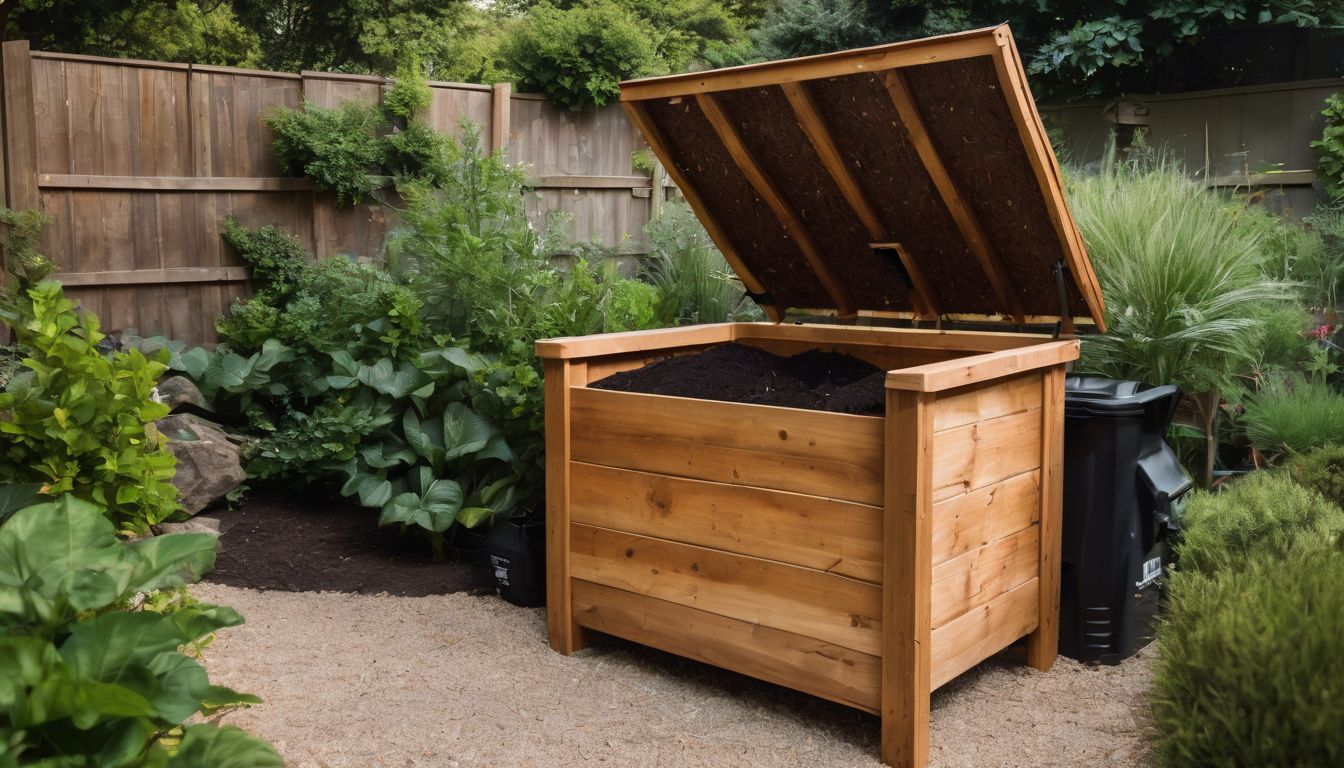Composting is brilliant for the planet, but the stink can be a real problem. Every year, tons of organic waste get transformed into nutrient-rich compost, but often with an unwanted side-effect: foul odours.
Our guide will reveal strategies to keep your compost heap from smelling like yesterday’s rubbish. Discover how to create odorless compost and enjoy a fresher tomorrow!
Key Takeaways
- Regularly turning and maintaining the right moisture level in your compost pile are vital steps to prevent bad smells, supporting aerobic decomposition which neutralises odours.
- Implementing an odor management plan is essential for large-scale composting facilities, involving monitoring levels of smell and using biofilters or catalysts to break down pungent compounds.
- Ecosorb is a natural product that you can use on your compost to tackle nasty smells by neutralising smelly compounds like ammonia and sulfur effectively.
- By carefully choosing where to place your compost pile, with good drainage and air flow far from neighbours, you can keep odour issues under control.
- Keeping a healthy balance between green materials like veggie scraps and brown materials such as leaves in the pile ensures microorganisms have what they need to decompose waste without producing foul smells.
Understanding Composting Odors
Composting odors can be caused by compounds such as sulfur and ammonia, which are a byproduct of aerobic composting. Understanding the science behind these odors is essential for effective odor management in composting facilities.
Causes of odor (sulfur, ammonia)
In the heart of composting, microorganisms break down organic matter, releasing various gases as byproducts. Among these gases, sulphur compounds often arise when materials rich in proteins and amino acids decompose without enough oxygen.
This can emit a strong smell similar to rotten eggs. Ammonia is another common offender that produces a pungent odour. It’s typically generated when there’s an excess of nitrogen-rich materials like kitchen scraps or garden waste undergoing decomposition.
Effective management hinges on balancing these elements within your compost pile. Ensuring adequate oxygen levels through regular turning aids in minimising the production of malodorous sulphur compounds and ammonia emissions during aerobic breakdowns.
Next, let’s dive into how aerobic composting can further help control foul odours at your facility.
Aerobic composting
Aerobic composting, facilitated by aerobic bacteria, is a method that involves the use of oxygen to decompose organic matter. This process efficiently breaks down compost materials and helps in controlling foul odors usually associated with anaerobic decomposition.
The presence of oxygen supports microbial activity, leading to the breakdown of organic waste without producing noxious smells.
Active composting methods such as regular turning and maintaining proper moisture balance contribute to successful aerobic composting. These activities promote waste treatment while reducing environmental pollution caused by offensive odors commonly found in commercial compost facilities.
Methods for Managing Compost Odors
Implementing an odor management plan and regularly monitoring odors can help to identify and address any issues. Technology solutions such as catalysts and biofilters are also effective in reducing compost odors.
Odor management plan
Implementing an effective odor management plan is crucial for composting facilities to control and eliminate foul odors. This involves regular monitoring of odor levels, identifying the sources of odors, and taking proactive measures to address them.
Additionally, having a well-documented plan in place ensures that all staff are aware of their roles and responsibilities in managing compost odors effectively.
A comprehensive odor management plan may include strategies such as proper maintenance of compost piles, regular turning of the compost to aerate it, maintaining the right moisture balance, and implementing biofilters or other technology solutions when needed.
Odor-monitoring
To ensure a pleasant composting environment, regular odour monitoring is essential. Utilising technology solutions such as biofilters and catalysts help in effectively controlling foul odours.
Additionally, establishing an odour management plan will enable proactive measures to be taken in controlling any unpleasant smells that may arise during the composting process.
Implementing an effective odour-monitoring system can significantly contribute to maintaining a clean and odour-free compost facility. Regular checks on air quality and utilising appropriate technology solutions are essential for preventing unwanted odours from affecting the surrounding environment.
Technology solutions (catalysts, biofilters)
Catalysts and biofilters are effective technology solutions for managing composting odours. These systems work by breaking down odorous compounds into less potent substances. Catalysts initiate chemical reactions that convert noxious gases into harmless by-products, while biofilters use microorganisms to naturally neutralise malodorous emissions.
Implementing these technologies can significantly reduce foul odours at composting facilities, promoting a more pleasant environment for workers and nearby communities.
By harnessing the power of catalysts and biofilters, compost facilities can proactively address odour issues while aligning with sustainable practices. Embracing these innovative solutions demonstrates a commitment to responsible waste management and environmental stewardship within the community.
Natural Solutions for Odor Control
To combat foul odors in composting, natural solutions like using Ecosorb and properly managing the compost pile can be effective. These methods help to control and eliminate unwanted odors while promoting a healthier environment for all.
Use of Ecosorb
Ecosorb is an effective natural solution for managing compost odors. It works by neutralising the compounds that cause foul smells, such as ammonia and sulfur. Ecosorb can be applied directly to the compost pile or used in a misting system to control odors at composting facilities.
Its eco-friendly nature makes it an ideal choice for environmentally conscious individuals looking to eliminate sewage-like smells while supporting conservation efforts.
By using Ecosorb, composters can effectively address odor concerns without resorting to harsh chemicals or artificial fragrances, contributing positively to their overall environmental impact.
Proper compost pile management
After addressing the use of Ecosorb for compost odor control, it’s vital to ensure proper compost pile management to further eliminate odors and maintain an environmentally friendly composting process. Here are some essential tips for managing your compost pile effectively:
- Maintain a good balance of green and brown materials in your compost pile.
- Ensure proper aeration by turning the compost regularly to promote decomposition.
- Keep the compost pile moist, but not wet, to support microbial activity.
- Use a cover for your compost pile to prevent excessive moisture and potential odor release.
Tips for Odor-Free Composting
To prevent foul odours in your compost, it is important to maintain proper moisture balance and regularly turn the compost pile. Additionally, consider the location of your compost pile to minimise odour impact.
Proper moisture balance
Maintaining proper moisture balance is essential for controlling compost odours. Excessive moisture can lead to anaerobic conditions, causing foul smells like the dreaded “sewage smell.” Conversely, insufficient moisture hinders microbial activity required for effective decomposition.
To maintain an optimal balance, regularly check and adjust the moisture content of your compost pile using a simple squeeze test—aim for a damp but not soggy consistency. Properly aerating and turning the compost also helps distribute moisture evenly throughout the pile.
In addition to controlling odours, maintaining proper moisture levels supports efficient decomposition and creates high-quality compost while reducing greenhouse gas emissions. Implementing these strategies ultimately leads to more successful and sustainable composting practices overall.
Regular turning of compost
Regularly turning your compost is essential for managing odors. Turning the compost pile helps to aerate it, allowing oxygen to reach all parts of the pile and promoting aerobic decomposition.
This active process also helps ensure that organic matter decomposes evenly, reducing the risk of foul odors caused by anaerobic conditions.
Turning the compost every few weeks with a pitchfork or shovel can help maintain an optimal moisture balance while preventing pockets of stagnation where odor-causing compounds might accumulate.
Compost pile location
Choosing the right location for your compost pile is crucial for managing odours. Select a well-drained area with good air circulation to prevent unpleasant smells from lingering. Ensure the spot is away from neighbouring properties to minimise potential disturbances and complaints.
Now let’s move on to explore natural solutions for odour control in composting.
Conclusion
In conclusion, composting odours can be effectively managed through various methods. Implementing an odour management plan, utilising technology solutions such as biofilters and regular monitoring are essential steps in controlling foul odours at composting facilities.
Natural solutions like the use of Ecosorb and proper compost pile management also play a crucial role in eliminating unpleasant smells. By maintaining a balanced moisture level, regularly turning the compost pile, and choosing an appropriate location for the pile, individuals can contribute to odour-free composting practices.
FAQs
1. What is odour management in composting?
Odour management in composting involves strategies to prevent and control foul odours from emerging while breaking down organic waste.
2. How can I prevent bad smells from my compost pile?
You can prevent bad smells by balancing green and brown materials, ensuring proper aeration, and occasionally turning the pile for aerobic odour control.
3. Can biofilters help with compost facility odour issues?
Yes, using a biofilter for odour control can effectively capture and neutralise the sewage smell at your compost facility.
4. Is there a special plan for managing odours at large composting facilities?
Composting facilities often implement an odour management plan that includes regular monitoring, proactive prevention techniques, and quick responses to any detected foul odours.
5. Are there ways to eliminate existing odours if my compost already smells?
Yes, you can manage existing unpleasant smells by adjusting the moisture levels, adding more browns like dry leaves or straw, and improving airflow through the pile to speed up odour elimination.





